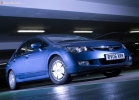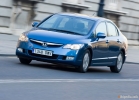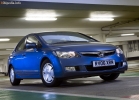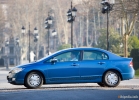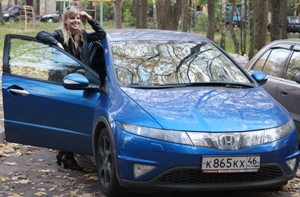Test drive Honda Civic sedan 2006 - 2008 sedan
Second-Hand-Honda Civic from $ 10,000

The sixth generation of Honda Civic was produced from 1995 to 2001. Among the motorists of Civic, he gained an athlete’s reputation, which is actually true only with regard to the most powerful versions. And most modifications are reliable inexpensive cars with good running qualities.
Engines
The cars in question were equipped with five types of 4-cylinder 16-valve gasoline engines. Two engines with a volume of 1.4 liters differed in power (92 and 102 hp) and had a fairly simple design with one camshaft in the block head. Another 1.5-liter engine, also with one camshaft, had a system for changing the VTEC gas distribution phase. And engines with a volume of 1.6 liters differed very significantly from each other. Less powerful, in design exactly the same as a 1.5-liter, produced 125 hp, and cars with these motors had a 1.6 VTEC nameplate. The second engine with index B16A2 is a completely different design. Two camshafts in the head of the block, a system for changing the phases of gas distribution and a power of 160 hp, that is, the same grandmaster 100 forces per liter. But there were few such machines, and finding a good copy of 1.6 VTI (as this modification was designated) is not easy, and it will cost significantly more than its simpler counterparts. In addition, these bullets, as a rule, were in the hands of racers and were inherently operated, so everything that will be said about the Civic resource does not apply directly to 1.6 VTI. This modification must be bought with a special approach.
There are also options with the Rover diesel engine, but there are very few of them, so we will not dwell on them in detail.
Honda engines have an interesting feature: their crankshafts rotate counterclockwise, while in the vast majority of other engines rotation is clockwise. Honda argues that in this direction of rotation, the intensity of wear is reduced and the resource of the unit increases. The atypical direction of rotation of the crankshaft should be remembered by purchasing oil seals on the engine: at the Honda oil seals, oil sulfine risks are directed to the opposite compared to others, and it is pointless to select the suitable in size from other engines, the oil will flow through them with a stream. If you are going to change the timing belt, it is better to have a crankshaft and camshaft oil seals in advance in advance, because if you need to replace them along the way, you may have to wait for delivery for several days or weeks, since you can’t buy these incorrect seals in any car shop.
Native seals withstand a mileage of 200 thousand km or more, therefore, if you have a motor with leaky seals and a mileage of less than 100 thousand km, most likely, either a speedometer, or there was overheating. First of all, leaks are noticeable at the junction of the lid and the case of the ignition distributor. Another good, albeit indirect, mileage indicator, can be the condition of the graduate collector. After 100 thousand km, this tin has a pretty decent look, and if it is rusty and all in the holes, the car drove significantly more than 100 thousand km. When examining the engine compartment, you should pay attention to the state of engine supports: if the motor is uneven and vibrations are transmitted to the body, it means that the geometry of the front of the body is disturbed. As for the resource of the engines, then 350 thousand km without repair is not the limit for them, if they serve them on time and correctly. In our conditions, the replacement of oil and filters ($ 140) should be carried out every 10 thousand km, checking and, if necessary, adjusting the gaps of valves - every 40 thousand km, and the replacement of the timing belt ($ 240) - every 100 thousand km. The spark plugs and high -voltage wires change as necessary, since the resource of candles largely depends on the quality of the fuel. Honda PGM-Fi injection systems are very reliable, and, according to experts involved in the repair of power systems, there are almost never problems with them.
Transmission
Civic was equipped with two types of mechanical 5 -speed gearboxes: one was installed on 1.6 VTI, the second - on all the rest. Oil replacement in the checkpoint is required every 40 thousand km, it is necessary to fill in the branded MTF-C, but the use of a 10W30 or 10W40 motor oil is allowed with a simultaneous reduction in the replacement interval. In addition, Civic was equipped with a 4-band automaton, the oil in which should be changed every 80 thousand km. It is necessary to use DEXTron III. Another pretty interesting type of transmission is CVT's unaccounted variator. Although such a design for Honda is a novelty, it works reliably, there are no complaints about it. Oil is replaced once every 45 thousand km, it is advisable to use special oil, but dextron is also suitable, while it is necessary to reduce service intervals. Circules are very durable, if you monitor the condition of the anthers, there should be no problems with them.
Suspension and steering
The civic suspension on double levers not only provides remarkable controllability and stability, but also differs in reliability and durability. True, constructively, it is quite complex, with a large number of elements. There are 24 units of silent blocks. From this it follows that you should not buy a used car with a tangled pendant, because the repair will fly into a penny. Of course, as of the suspension, it is difficult to judge the run of the car, because a lot depends on the driving manner, but on good European roads in rare cases it is necessary to change anything other than rods of the stabilizer up to 150 thousand km.
Therefore, the bleached suspension and indications on the speedometer of 100 thousand km are brought to thoughts either about the mileage or about the operating mode. In the front suspension, it may be necessary to replace the upper ball supports ($ 190 with a lever) and lower ball supports ($ 95). In the rear suspension, the silent blocks of longitudinal levers are quite expensive ($ 350 with a lever), as well as rear hubs ($ 240). In general, you should not overload Civic. When checking the condition of the silent blocks, you need to remember that they are quite supple, but only those that are visible to the gaps are visible. Since the installation angles of both front and rear wheels are subject to adjustment, it would be nice to check the geometry of the suspension on the stand before buying, at the same time, in this case, it is easy to establish whether the body or suspension elements are deformed.
As for the steering, it does not cause any trouble to the owner, even on our roads the steering tips ($ 100) withstand 100 thousand km or more, the steering racks almost never dislike.
Brake system
Ahead of the disc brakes, behind disk or drum. They work reliably, ABS sensors from salt practically do not suffer, sometimes from some types of salt can be covered with a magneton -permeable raid themselves, which is why the sensors cease to see them. All the rest of the service boils down to periodic replacement of pads and disks. Naturally, brake fluid must be changed once every two years and monitor the condition of the brake hoses.
Body and electrical equipment
The sixth generation of Civic was produced with four types of bodies: a 3-door hatchback and a sedan gathered in Japan, a 5-door liftback of the English assembly and lived on the conveyor for only about a year (1998-1999), a station wagon called Aerodeck, which was also produced in England , and in Japan. The corrosion resistance of the body is high, and if there was no mechanical damage, you do not need to worry about it. The interior decoration is inexpensive, typical of mass Japanese cars of those years, so you should not demand a luxurious and silent salon from the usual Civic. The ergonomics of the driver’s place is good, people who have been traveling to Europeans before, due to the low glazing line, will seem high, but it provides a good review. It should be noted that a 3 -door hatchback is mainly for two, because there is not enough space and a place in the back, and it is inconvenient to climb there.
The remaining versions are more suitable for transportation of four to five people, but the car is still small, and there are few places behind. The operation of electrical equipment does not cause any complaints, and the rules for handling it are only the nature of general recommendations, fair not only for Honda. So, for example, it is not worth using electric windows in the frost until the salon is heated - the glass is froze to the seals, and as a result, either the drive breaks or burns the electric motor. Otherwise, everything boils down to the periodic replacement of burned light bulbs. If you still have problems with the ignition, then candles or high -voltage wires are almost certainly to blame, because switches, runners, and ignition distributor covers are very durable.
Tuning
Civic is one of the favorite tuning objects on both sides of the ocean. Sets for finalizing the motor, transmission, suspension, appearance in catalogs simply cannot be counted. Another thing is that tuning, like the AP-Grad of a computer, is never the last. In addition, riding all the money inherent in the owners of such pains often leads to the fact that the money is quickly ending, and in order not to repair the car, it is simply sold. Therefore, tuned cars should be bought only after a thorough diagnosis. It may be cheaper to buy a standard car and finalize it to your liking than to raise a tuned, but already rolled up by the previous owner.
conclusions
When acquiring Civic, it should be borne in mind that this is still an inexpensive Japanese small draft, and you should not expect something supernatural from it. Versions with conventional engines have the usual dynamic characteristics for such volumes of engines and not particularly tractic at low speeds. True, thanks to a double -leaf suspension, any civic will give pleasure to their behavior on the road, these cars are rather nimble and agile, easy to drive. But the back of the coin is a small road clearance with all the ensuing consequences. Civic is a driving machine exclusively on asphalt, and this must be borne in mind when planning a purchase. High reliability and durability of the car does not mean at all that you should buy the first instance that came across. It is better to approach the issue thoroughly, it is imperative to diagnose at a station that is seriously engaged in these machines, except for external inspection and diagnostics of the suspension, be sure to check the car in motion, connect to the on -board computer and see if all systems and sensors are functioning properly, check the geometry of the body and already Then draw conclusions about the appropriateness of the purchase. With this approach, it is almost certainly possible to purchase a successful car and not know any worries with it later. For CIVIC, 2000 output in Moscow is asked from 10 thousand to 15 thousand dollars.
Some technical characteristics Honda Civic 1.5
(manufacturer data)
Dimensions, mm: 4190x1695x1380
Working engine volume, cubic meter. See: 1493
Max. Power, L.S./rpm: 114/6500
Max. moment, nm/rpm: 134/5500
Max. Speed, km/h: 238
Acceleration time 0-100 km/h, s: 10.3
Fuel consumption, l/100 km city/highway: 8.1/5.8
Leonid Klimanovich
Source: Avtopanorama magazine
Honda Civic Crash Test Video Sedan 2006 - 2008
Honda Civic Sedan 2006 test drives - 2008
Honda Civic Crash Test Sedan 2006 - 2008
Krassh Test: Detailed Information31%
Driver and passengers
21%
Pedestrians
38%
Children-passengers

